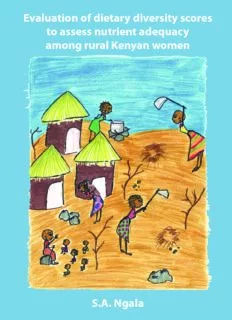
Evaluation of dietary diversity scores to assess nutrient adequacy PDF
Preview Evaluation of dietary diversity scores to assess nutrient adequacy
E Evaluation of dietary diversity scores INVITATION v a l u a to assess nutrient adequacy ti You are cordially invited to attend o n the ceremony of my PhD thesis o among rural Kenyan women f defence entitled d i e t a Evaluation of dietary diversity r y d scores to assess nutrient i v e adequacy among rural r s i Kenyan women t y s c o On Wednesday, 9 September 2015 r e s at 11:00 a.m. t o at the Aula of a s Wageningen University s e s Generaal Foulkes 1a, Wageningen s n u t The ceremony will be followed by a r i e reception in the Aula n t a d e q u a c y a m o n g r u r a l K e n y a n w o m e Sophie Ngala n S sophiengala @yahoo.com .A Paranymphs . N g a Dr. Fränzel van Duijnhoven l a 2 Franzel.duijnh [email protected] 0 1 S.A. Ngala Malgorzata Krolicka 5 [email protected] Evaluation of dietary diversity scores to assess nutrient adequacy among rural Kenyan women S. A. Ngala 1 Thesis committee Promotor Prof. Dr F. J. Kok Professor of Nutrition and Health, Division of Human Nutrition Wageningen University Co-promotors Dr I. D. Brouwer Associate Professor, Division of Human Nutrition Wageningen University Dr Alice M. Mwangi Senior Lecturer, Department of Food Science, Nutrition and Technology. University of Nairobi, Kenya Other members Prof. Dr E. G. Schouten, Wageningen University Dr G. L. Kennedy, Bioversity International, Italy Prof. Dr H. A. I. Bras, Wageningen University Dr A. Geelen, Wageningen University This resea rch was conducted under the auspices of the Graduate School VLAG (Advanced studies in Food Technology, Agrobiotechnology, Nutrition and Health S ciences) 2 Evaluation of dietary diversity scores to assess nutrient adequacy among rural Kenyan women S. A. Ngala Thesis submitted in fulfilment of the requirements for the degree of doctor at Wageningen University by the authority of the Rector Magnificus Prof. Dr A. P.J. Mol, in the presence of the Thesis Committee appointed by the Academic Board to be defended in public on Wednesday 9 September 2015 at 11:00 a.m. in the Aula. 3 Sophia A. Ngala Evaluation of dietary diversity scores to assess nutrient adequacy among rural Kenyan women 149 pages. PhD thesis, Wageningen University, Wageningen, NL (2015) With references, with summaries in English ISBN 978-94-6257-423-6 4 Dedicated to daughter Sally, Mum Teresa, Late Dad Ngala, Sella, Lucy, Jane, Magdalene, Christopher and Angela 5 6 Abstract Background : The major cause of micronutrient deficiencies is low intake due to monotonous diets, especially among women of childbearing age. The dietary diversity score has been proposed and validated as a good proxy indicator for micronutrient adequacy. However, there are still outstanding methodological questions related to seasonal effects, food intake methods, selection of foods and the cut-off for estimating the prevalence of acceptable nutrient adequacy. This thesis evaluated the performance of a simple dietary diversity score for assessing nutrient adequacy in the dMieettsh oofd rsural women in Kenya. : The study was conducted in Mbooni Division, Makueni District, Kenya among non-pregnant, non-lactating women of reproductive age having a child between 2-5 years. Food consumption data was collected by 3 non-consecutive quantitative 24hr-recalls and a qualitative free-listing 24hr-recall, in pre-harvest (Period 1, October 2007, n=73) and post-harvest (Period 2, April 2008, n=203) seasons. Dietary diversity scores (DDS) were derived based on 10 and 13 food groups with a minimum intake threshold per food group of 0 and 15 g, respectively. Mean pRreosbualbtsil:ity of adequacy (MPA) was calculated based on intake of 11 micronutrients. The dietary diversity score (DDS) and mean probability of adequacy (MPA) were significantly but moderately associated in both seasons (r=0.40 and r=0.38 in Period 1 and 2), and the association was independent of season (p=0.45). The DDS from a qualitative 24hr-recall (DDSql) showed little agreement with the quantitative 24hr-recall (DDSqn) with a mean difference (DDSqn-DDSql) of -0.51±1.46 (Period 1) and -0.58±1.43 (Period 2), with lower correlations between MPA and DDS for DDSql (r=0.14 and 0.19 in Period 1 and 2, p>0.05) compared to DDSqn (0.40 and 0.54 in Period 1 and 2, p<0.01). The informative food-based scores and the food group-based scores were moderately associated with mean probability of adequacy (r=0.54-0.59 in Period 1; r=0.37-0.45 in Period 2) with higher values for informative food-based scores. The Minimum Dietary Diversity score for Women and mean probability of adequacy were significantly but moderately associated in both seasons (r=0.43-0.58 in Period 1; r=0.24-0.50 in Period 2), but the use of the cutoff of consuming 5 or more food groups as indication of nutrient adequacy resulted in high total misclassifications in both periods. 7 Conclusion: A dietary diversity score can be used as a simple proxy indicator for micronutrient adequacy, independent of season. The dietary diversity score derived from a qualitative free-listing 24hr-recall formed a poor indicator, needing further refinement to improve its performance. The informative food-based score performs moderately better in predicting nutrient adequacy, but its advantages do not outway those of the food group-based scores, and the latter is therefore preferred. The Minimum Dietary Diversity score for Women, formed a good indicator to predict nutrient adequacy, but using the cutoff of 5 or more food groups resulted in an overestimation of prevalence of adequate intake in our resource poor population. 8
Description: